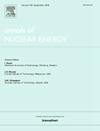意外情况下220MWe水冷通道热力学行为研究
IF 1.9
3区 工程技术
Q1 NUCLEAR SCIENCE & TECHNOLOGY
引用次数: 0
摘要
本文研究了印度重水堆(IPHWR)管道在冷却剂丢失事故(LOCA)和堆芯冷却系统紧急故障下的运行情况。基于实验数据,采用数值分析方法研究了压力管(PT)和万向管(CT)之间的温度分布、结构变形和传热。正如过去的研究所观察到的那样,上述事故后释放的燃料束产生的过量热量会导致下垂,进一步导致PT-CT接触,PT-CT接触是至关重要的散热器,本质上是防止熔芯的被动对策。结果与实验数据相吻合,关键发现表明PT-CT接触过程中PT和CT的温度都有显著变化,这也减少了大量的热量。此外,随着温度的升高,PT熔化的风险在高热量下仍然存在。本文章由计算机程序翻译,如有差异,请以英文原文为准。
Investigation of thermo-mechanical behaviour of 220MWe IPHWR channel under accdiental scenario (LOCA)
This study focuses on Indian Pressurized Heavy Water Reactor (IPHWR) channel under Loss of Coolant Accident (LOCA) and Emergency Core Cooling System failure. The study utilizes numerical analysis based on experimental data to investigate temperature distribution, structural deformation, and heat transfer between the pressure tube (PT) and calandria tube (CT). As observed in past studies, the excessive heat from the fuel bundle released after the aforementioned accident causes sagging, further leading to PT-CT contact, which acts as a crucial heat sink, essentially acting as a passive countermeasure against meltdown. The results match with the experimental data and key findings indicates significant temperature variations in both PT and CT during PT-CT contact, which also mitigates significant amounts of heat. Further as the temperature increases the risk of PT melting persists at high amounts of heat.
求助全文
通过发布文献求助,成功后即可免费获取论文全文。
去求助
来源期刊

Annals of Nuclear Energy
工程技术-核科学技术
CiteScore
4.30
自引率
21.10%
发文量
632
审稿时长
7.3 months
期刊介绍:
Annals of Nuclear Energy provides an international medium for the communication of original research, ideas and developments in all areas of the field of nuclear energy science and technology. Its scope embraces nuclear fuel reserves, fuel cycles and cost, materials, processing, system and component technology (fission only), design and optimization, direct conversion of nuclear energy sources, environmental control, reactor physics, heat transfer and fluid dynamics, structural analysis, fuel management, future developments, nuclear fuel and safety, nuclear aerosol, neutron physics, computer technology (both software and hardware), risk assessment, radioactive waste disposal and reactor thermal hydraulics. Papers submitted to Annals need to demonstrate a clear link to nuclear power generation/nuclear engineering. Papers which deal with pure nuclear physics, pure health physics, imaging, or attenuation and shielding properties of concretes and various geological materials are not within the scope of the journal. Also, papers that deal with policy or economics are not within the scope of the journal.
 求助内容:
求助内容: 应助结果提醒方式:
应助结果提醒方式:


